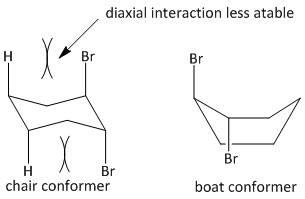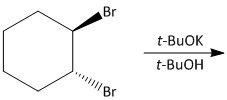
Answer
453k+ views
Hint: Cyclohexane exists in chair and boat conformations. The boat form is more stable conformer, but during a reaction it transforms into chair form. \[t - BuOK\] is a very strong base used for abstracting protons.
Complete step by step answer:
The trans-\[1,2\]-dibromocyclohexane exists in the form of chair and boat conformation. The boat conformation is of lower energy and more stable and the chair conformation is of higher energy and less stable due to diaxial interactions between the large bromine and hydrogen atoms.

For the given reaction, when trans-\[1,2\]-dibromocyclohexane was treated with potassium t-butoxide in t-butanol, an elimination reaction will occur. Potassium t-butoxide is known as a very strong base and used for abstraction of protons.
For the given compound the proton present on the carbon adjacent to the carbon attached to bromine will be abstracted by the base. This will result in two \[E2\] types of elimination reactions causing release of bromine atoms in the form of \[HBr\].
For the \[E2\] elimination an antiperiplanar orientation is required. Such orientation is only possible for a chair conformer and not a boat conformer. The hydrogen atoms at the \[C3\] and \[C6\] position of the Cyclohexane ring are antiperiplanar with the bromine atoms at \[C1\] and \[C2\].
The mechanism for the \[E2\] elimination is as follows:

Thus the option C is the correct answer, i.e. Cyclohexane-\[1,3\]-diene.
Note:
Elimination reactions are of various types like \[E1\], \[E2\] and \[E1cb\]. Unlike \[E2\] which is bimolecular with respect to substrate and the base, \[E1\] is unimolecular which includes formation of stable carbocation and \[E1cb\] which is unimolecular conjugate base elimination. The stereochemistry of the product varies according to the type of elimination.
Complete step by step answer:
The trans-\[1,2\]-dibromocyclohexane exists in the form of chair and boat conformation. The boat conformation is of lower energy and more stable and the chair conformation is of higher energy and less stable due to diaxial interactions between the large bromine and hydrogen atoms.

For the given reaction, when trans-\[1,2\]-dibromocyclohexane was treated with potassium t-butoxide in t-butanol, an elimination reaction will occur. Potassium t-butoxide is known as a very strong base and used for abstraction of protons.
For the given compound the proton present on the carbon adjacent to the carbon attached to bromine will be abstracted by the base. This will result in two \[E2\] types of elimination reactions causing release of bromine atoms in the form of \[HBr\].
For the \[E2\] elimination an antiperiplanar orientation is required. Such orientation is only possible for a chair conformer and not a boat conformer. The hydrogen atoms at the \[C3\] and \[C6\] position of the Cyclohexane ring are antiperiplanar with the bromine atoms at \[C1\] and \[C2\].
The mechanism for the \[E2\] elimination is as follows:

Thus the option C is the correct answer, i.e. Cyclohexane-\[1,3\]-diene.
Note:
Elimination reactions are of various types like \[E1\], \[E2\] and \[E1cb\]. Unlike \[E2\] which is bimolecular with respect to substrate and the base, \[E1\] is unimolecular which includes formation of stable carbocation and \[E1cb\] which is unimolecular conjugate base elimination. The stereochemistry of the product varies according to the type of elimination.
Recently Updated Pages
What is IUCN A Indian Union for Conservation of Nature class 10 social science CBSE

The provision for the Contingency Fund of India as class 10 social science CBSE

Which country did Learie Constantine belong to A West class 10 social science CBSE

Adolf Hitler a Where was Adolf Hitler born b What was class 10 social science CBSE

Which one of the following is the artificial lake in class 10 social science CBSE

What is the National food for Work Programme NFWP class 10 social science CBSE

Trending doubts
How do you graph the function fx 4x class 9 maths CBSE

Which are the Top 10 Largest Countries of the World?

Fill the blanks with the suitable prepositions 1 The class 9 english CBSE

What is the meaning of sol in chemistry class 11 chemistry CBSE

The Equation xxx + 2 is Satisfied when x is Equal to Class 10 Maths

The capital of British India was transferred from Calcutta class 10 social science CBSE

Why is there a time difference of about 5 hours between class 10 social science CBSE

Capital of the Cheras was A Madurai B Muziri C Uraiyur class 10 social science CBSE

What organs are located on the left side of your body class 11 biology CBSE









